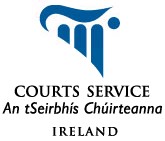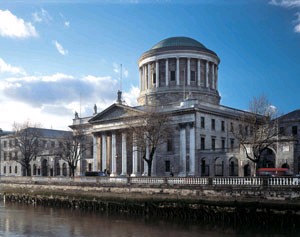
On Thursday 17th November the 3rd Year Civil Social and Personal Eduication Class (C.S.P.E.) visited the Four Courts in Dublin as part of their project work for their Junior Certificate Exams

General introduction to Four Courts history
Under English rule there had been two legal systems in Ireland; English law within the Pale and Brehon law beyond it. This latter, indigenous system continued until the early 17th century by which time English law prevailed. In 1775 it was deemed that the location of the old Four Courts, then in and around the environs of Christ Church cathedral, was so dilapidated, dispersed and inadequate that an entirely new structure should be built on what is the present site. Work began on Thomas Cooley’s designs for the Public Records Office (now part of the west courtyard) in 1776. Upon Cooley’s death in 1784, James Gandon, architect of the Customs house, essentially designed what we recognise as the Four Courts today (the courts, hall, dome and quadrangles were all added to Cooley’s building). Like many of Dublin’s finest buildings, the structure was almost completely destroyed during the civil war of 1922.
James Gandon
James Gandon, Dublin’s best known architect, was responsible for such works in the city as the Four Courts, the Custom House, the King’s Inns and additions to the Parliament House (now the Bank of Ireland). Born in England in 1743 of Huguenot descent, he remained there for his early life and built up a small architecture practice. In the late 1760s he entered a design in the competition for a new Royal Exchange but came second to Thomas Cooley. Little is known of his architectural work during the 1770s, however in 1780 he was invited to build in St. Petersburg by a Russian princess. He declined, but instead accepted an offer the following year to design a new Custom House in Dublin. He arrived in 1781 and so began his long association with the city which continued until his death in 1823. He is buried in Drumcondra cemetery.
Round Hall and Corinthian Columns
The Round Hall of the Four Courts has been described as the ‘physical and spiritual centre of the building’. This central block was at the heart of James Gandon’s changes to Thomas Cooley’s original architectural plans. Structurally, the hall and dome are largely as Gandon left them. The interior decoration was, however, much richer before the civil war damage of 1922. Statues of Irish judges and lawyers stood in the niches, the floor was flagged in stone and the dome enriched with the stucco work of sculptor Edward Smyth. The hall is surrounded by Corinthian columns which, again, were almost all shattered during the bombardment of the Civil War
The Dome
The dome of the Four Courts is a prominent feature of Dublin’s skyline and even appeared on former Irish currency (the £20 note). It may have been initially intended as a library but instead became a depository for the records of the Auditor General. By 1812, the weight of these documents had reached fifty two tons and they had to be removed to ensure the structural safety of the building. The dome was completely destroyed in 1922. However, T.J. Byrne, principal architect at the Office of Public Works subsequent to the Civil War, led a restoration project on the Four Courts. This saw the dome rebuilt with reinforced concrete in an operation involving twenty men working for thirty hours.
The Central Office of the High Court
The Central Office of the High Court is the location where the vast majority of High Court civil cases are initiated It occupies the entire ground floor of the East Wing of the Four Courts. Unchanged for the most part since the foundation of the state, the office underwent extensive renovation work in 2002. Considerable changes were effected in the public access area including a bright and comfortable waiting area with specially designed seating and public access computers. The List Room is now on the first floor, close to the registrars’ offices, and easily accessible to the public.
The Judges’ Library
The Judges’ Library was originally located on the first floor of the East Wing of the Four Courts. Recent renovation works have resulted in a move to Ãras uà Dhálaigh beside the Four Courts building. Unlike the previous location, there is room for visitors to browse, sit and study with comfortable seating and research stations. Computers are available for use by visitors to the library which facilitates both access to the electronic subscriptions of the library and work on research.